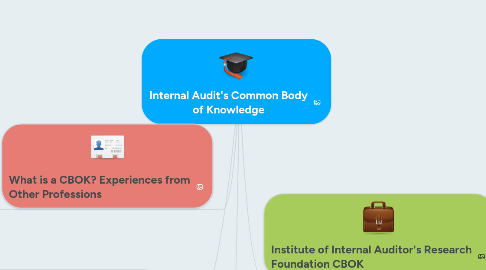
1. Modern Internal Auditing's CBOK Going Forward
1.1. IIARF CBOK study mentions Emerging Markets and Globalization as two potential but highly scored emerging issues
2. What Does an Internal Auditor Need to Know ?
2.1. Internal auditor should be able to use some of that knowledge to merge with internal audit principles as appropriate
2.2. Newer Internal Auditors can use material COSO to gain a better understanding of the depth and breadth of modern internal auditing
3. What is a CBOK? Experiences from Other Professions
3.1. Definition
3.1.1. the minimum level of proficiency needed for effective performance within that profession
3.1.2. focuses on the minimal knowledge needed by any professional in that discipline to perform effectively
3.1.3. example: Bank Administration Institute (BAI : www.bai.org) has released a CBOK for banking industry risk profesional
3.2. Relationship CBOK to other knowledge Areas
3.2.1. Generally Accepted Internal Audit Standards and Best Practices
3.2.2. General Management Knowledge and Practices
3.2.3. Application Area Knowledge and Practice
4. Institute of Internal Auditor's Research Foundation CBOK
4.1. Objectivity internal auditing professional practice
4.1.1. 1. The knowledge and skill that internal auditors possess
4.1.2. 2. The skill and organizational levels used for the practise of internal auditing work
4.1.3. 3. The actual duties performed by internal auditors
4.1.4. 4. The structure of internal audit organizations
4.1.5. 5. The types of indutries which practice internal audit
4.1.6. 6. The regulatory environment of various countries
4.2. Three HARF CBOK evaluation Statement
4.2.1. 1. Your internal audit activity brings a systematic approach to evaluate the effectiveness of governess processes
4.2.2. 2. The way our internal audit activity adds value to the governance process is through direct access to the audit committee
4.2.3. 3. Compliance with the IIA's Standards for the Professional Practice of Internal Auditing is a key factor for your internal audit activity to add value to governance processes
4.3. Internal Audit tools and techniques
4.3.1. 1. Internet Web and E-mail
4.3.2. 2. Risk - Based Audit Planning
4.3.3. 3.Analytical Reviews
4.3.4. 4. Electronic Workpapers
4.3.5. 5. Statistical Audit Sampling
4.3.6. 6. Computer- Assisted Audit Techniques
4.3.7. 7. Flowchart Software
4.3.8. 8. Benchmarking
4.3.9. 9. Process Mapping Applications
4.3.10. 10. Control Self - Assessments
4.3.11. 11. Data Mining
4.3.12. 12. Continuous / Real Time Auditing
4.3.13. 13. IIA Quality Assessment Review Tools
4.3.14. 14. Balanced Scorecard
4.3.15. 15. Total Quality Management Techniques

